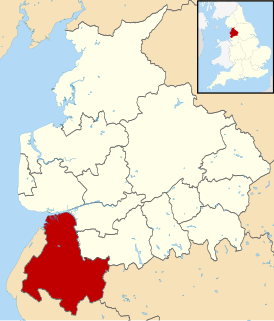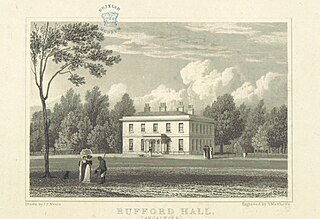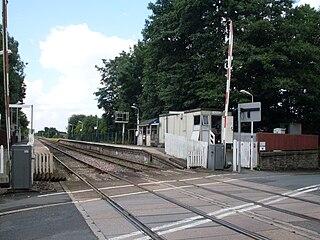
The River Douglas, also known as the River Asland or Astland, is a river that flows through Lancashire and Greater Manchester in the north-west of England. It is a tributary of the River Ribble and has itself several tributaries, the major ones being the River Tawd and the River Yarrow.

West Lancashire is a non-metropolitan district with the status of a borough in Lancashire, England. Its council is based in Ormskirk. The other town in the borough is Skelmersdale. The population of the District taken at the 2011 census was 110,685.
The district was formed in 1974 under the Local Government Act 1972, as a merger of Ormskirk and Skelmersdale and Holland urban districts along with part of West Lancashire Rural District and part of the former Wigan Rural District.

Baron Hesketh, of Hesketh in the County Palatine of Lancaster, is a title in the Peerage of the United Kingdom. It was created in 1935 for Sir Thomas Fermor-Hesketh, 8th Baronet, who had previously briefly represented Enfield in the House of Commons as a Conservative. As of 2010 the titles are held by his grandson, the third Baron, who succeeded his father in 1955. Lord Hesketh held junior ministerial positions in the Conservative administrations of Margaret Thatcher and John Major. However, he lost his seat in the House of Lords after the House of Lords Act 1999 removed the automatic right of hereditary peers to sit in the upper chamber of Parliament.

Baron Savile, of Rufford in the County of Nottingham, is a title in the Peerage of the United Kingdom. It was created in 1888 for the diplomat Sir John Savile. He was the eldest of the five illegitimate children of John Lumley-Savile, 8th Earl of Scarbrough, and the grandson of John Lumley-Savile, 7th Earl of Scarbrough. The latter was the fourth of the seven sons of Richard Lumley-Saunderson, 4th Earl of Scarbrough, and his wife Barbara, sister and heiress of the politician Sir George Savile, 8th and last Baronet, of Thornhill, who bequeathed the substantial Savile estates in Yorkshire and Nottinghamshire to his nephew the Hon. Richard Lumley-Saunderson, later 6th Earl of Scarbrough.
On his death the estates passed to his younger brother, the aforementioned seventh Earl, and then to his son the eighth Earl. The latter bequeathed the estates to his second natural son Captain Henry Lumley-Savile. When he died they passed to his younger brother Augustus William Lumley-Savile (1829–1887) and then to his eldest brother, the aforementioned John Savile, who was created Baron Savile the following year.

Martin Mere is a mere near Burscough, in Lancashire, England, on the West Lancashire Coastal Plain. The mere is a vast marsh, around grid reference SD 41 15 that was, until it was drained, the largest body of fresh water in England.
The Ormskirk branch line is a railway line in Lancashire, England, running between Preston and Ormskirk. The train service is operated by Northern. The line is the northern section of the former Liverpool, Ormskirk and Preston Railway; the line from Ormskirk to Liverpool is now part of Merseyrail's Northern Line. Prior to the introduction of the 1970–71 London Midland Region timetable, it was a secondary main line from Liverpool to Scotland, Blackpool, and Yorkshire. From 4 May 1970, however, the line was severed at Ormskirk. With express trains eliminated, stopping services at the village stations en route were improved, and have retained a similar frequency to this day.

Rufford Abbey is a country estate in Rufford, Nottinghamshire, England, some 2 miles (4 km) south of Ollerton. Originally a Cistercian abbey, it was converted to a country house in the 16th century after the Dissolution of the Monasteries. Part of the house was demolished in the 20th century, but the remains, standing in 150 acres of park and woodland, are open to the public as Rufford Country Park. Part of the park is a Local Nature Reserve.

Holmeswood is a small agricultural village in West Lancashire, in the north-west of England. It lies just north of the Martin Mere Wetland Centre and to the south of North Meols about six miles east of the Irish Sea coast at Southport.

Rainworth Water is a watercourse that is a tributary of the River Maun near Rainworth, Nottinghamshire, England. It is characterised by a number of lakes, including that which forms part of the country park at Rufford Abbey. L Lake at Rainworth forms part of the Rainworth Lakes Site of Special Scientific Interest. There are two designated Local Nature Reserves along its length, one of which is also known by the name Rainworth Water. The Rainworth Water LNR is owned and managed by Nottinghamshire County Council.

Mawdesley is a village and civil parish in Lancashire, England, which had a population of 1,702 at the 2011 Census.
Rufford Comprehensive School was a secondary school in the village of Edwinstowe in Nottinghamshire, England which opened its doors in September 1976 and closed in 2003.

Cratley is a lost village in Nottinghamshire, England. It may have been located close to North Laithes Farm at Kneesall although an alternative site east of Laund Wood has been suggested. Another name's for the settlement is Cratela, or Creilage. Two field names on the Estate Map of the Liberty of Rufford i.e. in 1637 are given as East and West Credlin.

Sollom is a hamlet in the parish of Tarleton, in Lancashire, England. It lies south of Tarleton and north of Rufford on the A59 road, giving the village good links to Preston, Southport and Liverpool.

Mere Sands Wood is a 42 hectares nature reserve between the villages of Holmeswood and Rufford in west Lancashire, England, managed by The Wildlife Trust for Lancashire, Manchester & North Merseyside. It lies about five miles from Ormskirk. The name derives from when the area was on the shore of Martin Mere.

The hall house is a type of vernacular house traditional in many parts of England, Wales, Ireland and lowland Scotland, as well as northern Europe, during the Middle Ages, centring on a hall. Usually timber-framed, some high status examples were built in stone.
Rufford is a civil parish in the West Lancashire district of Lancashire, England. It contains ten buildings that are recorded in the National Heritage List for England as designated listed buildings. Of these, one is listed at Grade I, the highest of the three grades, and the others are at Grade II, the lowest grade. The parish contains the villages of Rufford and Holmeswood, as well as the surrounding countryside. The most important building in the parish is Rufford Old Hall; this and associated structures are listed. The Rufford Branch of the Leeds and Liverpool Canal passes through the parish and a lock on it is listed. The other listed buildings include houses, a church and a cross base in the churchyard, and a public house.
















